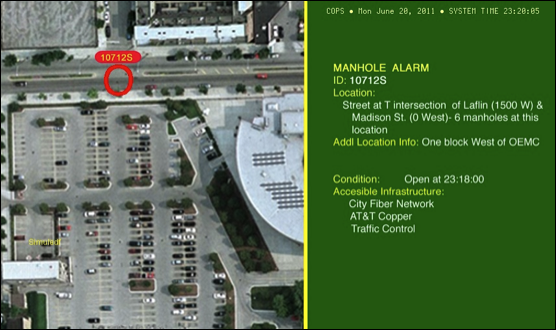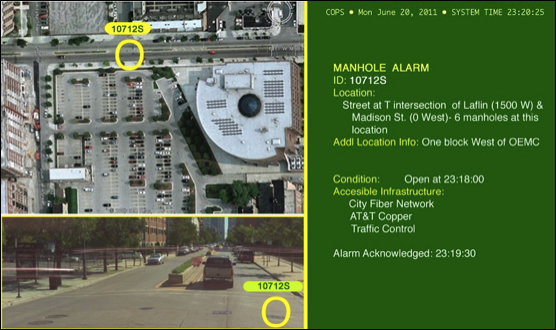
A vital new
surveillance and protection system for
Critical Underground Infrastructure

COPS™ SYSTEM FEATURES
Cover Open Transponders (COTS) are completely self-contained, waterproof and weatherproof units that require no routine maintenance.
COTS have no external wires or connectors and no mechanical switches to cause problems in the potentially harsh environment of a manhole.
COTS will operate for up to ten years on a self-contained internal battery system. Actual battery life is dependent on the programmed configuration of the COT.
COTS are easily installed by placing straps around its cylindrical body and securing the straps to the wall of the manhole.

Transceivers are easily attached to light standards and other structures, making installation fast and simple.
Transceivers and COTS use the Zigbee protocol that is self-configuring, so that a network is in place as soon as the transceivers and COTS are installed.
Continuously running automated Diagnostics and Self-Test features report any signal loss, or low power level and their locations to the monitoring center.
Network redundancy ensures that an alarm is never missed in case of a transceiver failure.
All power sources are designed for a ten-year operating life. The system continuously monitors all power sources. Aging batteries or damaged solar panels will be detected and reported to the monitoring center.
Firmware (software) can be uploaded over the Zigbee wireless network. This eliminates the need to physically access any device to install firmware upgrades.
The robust Zigbee protocol is designed specifically to avoid interference from Wi-Fi and other wireless networks and devices operating in the 2.4 Gigahertz radio band.
OPERATING SOFTWARE
The operator views maps of the streets or other areas where the manholes are located. Alarms are displayed on the maps and text will describe the alarm location and details. Operator interaction with the system can be by mouse or touch screen, while administrative and maintenance staff may also use the keyboard. Installations with larger networks may have more than one operating terminal, while maintenance and administrative functions may be performed on separate computers that are part of the network.
When an alarm occurs, it is annunciated both audibly and visually. The image below shows the location of the manhole in alarm mode as a red circle. The monitoring staff will acknowledge the alarm by clicking on the red circle or by touching the red area if a touch screen is installed.
Click Image to Enlarge
Clicking on an alarm will silence the audible alarm and cause a change in the screen display to indicate that the alarm has been acknowledged. This and all other activities are time stamped and stored to archives. The operator may review the alarm log at any time but may not alter it.
SYSTEM COMPONENTS
The following is a brief description of the primary components of the COPS™ system.
COVER OPEN TRANSPONDERS (COTS)
The COT is a sealed package containing an RF transceiver, batteries, and a method of sensing the position of the manhole cover. The package is made of ABS plastic, a material that is tolerant to cold weather and to substances that should normally be encountered in a manhole. Other plastics can be used for packaging to accommodate special situations.
The COT electronics module is designed specifically for operation with the Zigbee communications protocol.
If the COT has detected an open manhole, it transmits an alarm message. If the COT does not hear a response from a transceiver, it will attempt to re-establish communications.
The useful life of the COT battery pack is ten years.
TRANSCEIVER
Transceiver electronics are contained in a sealed cylindrical package to which a solar panel is attached. This assembly is mounted on a light standard or other suitable structure. Solar modules recharge the transceiver’s internal batteries.
The transceiver communicates with the COTS and relays their alarm status to the control computer, via other transceivers and point to point back-haul paths. The transceiver listens for messages from the COTS associated with it. Normally, it will receive an ‘all ok’ message from a COT. It will send an ‘all ok’ back to the COT to confirm that the message was heard, and relay the COTS ‘all ok’ to the control computer.
If the manhole cover has been removed, the message from the COT will indicate this change in status. Upon receipt of the status change to ‘cover open’, a transmissions will be initiated from the control computer to verify the status. The transceiver will then continue to receive and relay timed messages between the COT and the control computer. When the manhole cover has been closed, its change of status will be passed on by the transceiver.
In these situations, the transceiver is playing a passive role, relaying information between COTs and the control computer. However, if the transceiver detects a problem with communications, it will initiate an internal message of its own. The Zigbee network protocol has powerful algorithms for dealing with exceptions. All events are time stamped and recorded in statistical logs.
Situations such as a low battery or a device that has disappeared from the network, would be reported to the operator as an alarm requiring routine or immediate attention.
The useful life of the transceiver with rechargeable batteries is five years.
CLICK to request more information


